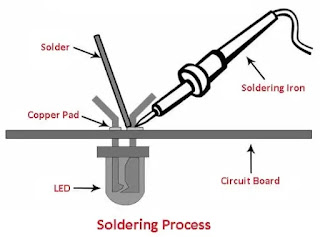Soldering and Types
સોલ્ડરિંગ 450 below C ની નીચે ગલનશીલ તાપમાન સાથે ફિલર મેટલના ઉમેરા દ્વારા મેટલ શીટ્સના બે ટુકડાઓમાં જોડાવાની પ્રક્રિયા છે.સોલ્ડરિંગ સામગ્રીનો ઉપયોગ સોલ્ડરિંગ પ્રક્રિયામાં થાય છે જેને સોલ્ડર કહેવાય છે જે ટીન અને લીડના એલોયથી બનેલો છે.
The flux material is also used in
the soldering process is made up of OS zinc chloride and ammonium chloride. The
function of flux is not permitted the molten solder to wet and flow into the
joint. Generally, lead and tin alloy are used in various compositions depending
upon the used of the joint.
સોલ્ડરિંગ
પ્રક્રિયામાં પ્રવાહ સામગ્રીનો પણ ઉપયોગ થાય
છે તે OS ઝીંક
ક્લોરાઇડ અને એમોનિયમ ક્લોરાઇડથી બનેલો છે. પ્રવાહના કાર્યને પીગળેલા સોલ્ડરને ભીના કરવા અને સંયુક્તમાં વહેવાની મંજૂરી નથી.
સામાન્ય રીતે, લીડ અને ટીન એલોયનો ઉપયોગ સંયુક્ત ઉપયોગના આધારે વિવિધ રચનાઓમાં થાય છે.
The strength of
the soldering joint depends upon the strength of the alloys and its adhesive
qualities. After soldering, the residues of flux should be removed by washing
thoroughly with water to avoid corrosion. The strength of the soldering joint
is relatively low. Soldering is commonly used in electric and electronic
applications, Sheet metal work wire terminals, sealing of metal containers and
similar small parts.
સોલ્ડરિંગ સંયુક્તની મજબૂતાઈ એલોયની તાકાત અને તેના એડહેસિવ ગુણો પર આધારિત છે. સોલ્ડરિંગ પછી, કાટને ટાળવા માટે પ્રવાહના અવશેષોને પાણીથી સારી રીતે ધોઈને દૂર કરવા જોઈએ. સોલ્ડરિંગ સંયુક્તની તાકાત પ્રમાણમાં ઓછી છે. સોલ્ડરિંગનો ઉપયોગ સામાન્ય રીતે ઇલેક્ટ્રિક અને ઇલેક્ટ્રોનિક એપ્લિકેશન્સ, શીટ મેટલ વર્ક વાયર ટર્મિનલ્સ, મેટલ કન્ટેનરની સીલિંગ અને સમાન નાના ભાગોમાં થાય છે.
Types of Soldering
સોલ્ડરિંગના પ્રકારો નીચે મુજબ છે:
·
Soft
soldering
·
Hard or
Silver soldering
·
Brazing
1. Soft Soldering
સોફ્ટ સોલ્ડરિંગનો ઉપયોગ શીટ-મેટલના કામમાં એવા ભાગોમાં જોડાવા માટે થાય છે જે ઉચ્ચ તાપમાને ખુલ્લા ન હોય અને ભારે ભાર અને દળોને આધિન ન હોય. સોફ્ટ સોલ્ડરિંગનો ઉપયોગ વાયર અને નાના ઘટકોમાં જોડાવા માટે પણ થાય છે.
The solder, which is mostly composed of lead and tin, has a melting range of 150 to 350°C. A suitable flux is always used in soft soldering.
સોલ્ડર, જે મોટે ભાગે લીડ અને ટીનથી બનેલું છે, તેની ગલન શ્રેણી 150 થી 350 ° સે છે. સોફ્ટ સોલ્ડરિંગમાં હંમેશા યોગ્ય પ્રવાહનો ઉપયોગ થાય છે.
Its function is to prevent oxidation of the surfaces to be soldered or to dissolve oxides that settled on the metal surfaces during the healing process. Although corrosive, Zinc chloride is the most common soldering flux.
તેનું કાર્ય સોલ્ડર કરવા માટે સપાટીઓના ઓક્સિડેશનને અટકાવવાનું અથવા હીલિંગ પ્રક્રિયા દરમિયાન ધાતુની સપાટી પર સ્થાયી થયેલા ઓક્સાઇડને ઓગાળવાનું છે. સડો હોવા છતાં, ઝીંક ક્લોરાઇડ એ સૌથી સામાન્ય સોલ્ડરિંગ પ્રવાહ છે.
The soft soldering has the
lowest filler metal melting point of all soldering types, which is less than
about 400°C, these filler metals are typically alloys, often with liquid
temperatures below 350°C.
સોફ્ટ સોલ્ડરિંગમાં તમામ સોલ્ડરિંગ પ્રકારોનો સૌથી ઓછો ફિલર મેટલ ગલનબિંદુ હોય છે, જે આશરે 400 ° સે કરતા ઓછો હોય છે, આ ફિલર ધાતુઓ સામાન્ય રીતે એલોય હોય છે, ઘણીવાર પ્રવાહી તાપમાન 350
below સે કરતા ઓછું હોય છે.
Due to the low temperatures
used in soft soldering, it thermally stresses components the least, but does
not create strong joints and is therefore unsuitable for mechanical
load-bearing applications.
નરમ સોલ્ડરિંગમાં
ઉપયોગમાં લેવાતા નીચા તાપમાને કારણે, થર્મલી તાણવાળા ઘટકો ઓછામાં ઓછા છે, પરંતુ મજબૂત
સાંધા બનાવતા નથી અને તેથી યાંત્રિક લોડ બેરિંગ એપ્લિકેશન્સ માટે અયોગ્ય છે.
2. Hard or Silver Soldering
It employs solder which metal at
higher temperatures and are stronger than those used in soft soldering. Silver
soldering is a hard soldering method, and silver mixed with tin is utilized as
a solder.
તે સોલ્ડરનો ઉપયોગ કરે છે જે ંચા તાપમાને મેટલ હોય છે અને સોફ્ટ સોલ્ડરિંગમાં વપરાતા ધાતુઓ કરતા વધુ મજબૂત હોય છે. સિલ્વર સોલ્ડરિંગ એ સખત સોલ્ડરિંગ પદ્ધતિ છે, અને ટીન સાથે મિશ્રિત ચાંદીનો સોલ્ડર તરીકે ઉપયોગ થાય છે.
The temperatures of the various hard solder vary from about 600 to 900°. The fluxes are mostly in paste form and are applied to the joint with a brush before heating. In hard soldering, a blowtorch constitutes the equipment.
વિવિધ હાર્ડ સોલ્ડરનું તાપમાન લગભગ 600 થી 900 vary સુધી બદલાય છે. પ્રવાહ મોટે ભાગે પેસ્ટ સ્વરૂપમાં હોય છે અને ગરમ કરતા પહેલા બ્રશ સાથે સંયુક્ત પર લાગુ થાય છે. સખત સોલ્ડરિંગમાં, બ્લોટોર્ચ સાધનોની રચના કરે છે.
The different compositions of
solder for different purposes are as follows:
વિવિધ
હેતુઓ માટે સોલ્ડરની વિવિધ રચના નીચે મુજબ છે:
Soft solder-lead 37%, tin 63%.
Medium solder-lead 50%, tin%.
Plumber’s solder-lead 70%, tin 30%.
Electrician’s solder-lead 58%, tin 42%.
3. Brazing
These types of soldering metal
use a very higher melting point than the metals used in hard and soft
soldering. However, it is similar to hard soldering, the metal being bonded is
heated as opposed to melting.
આ
પ્રકારની સોલ્ડરિંગ મેટલ સખત અને નરમ સોલ્ડરિંગમાં વપરાતી ધાતુઓ કરતાં ખૂબ જ વધારે ગલનબિંદુનો
ઉપયોગ કરે છે. જો કે, તે
સખત સોલ્ડરિંગ જેવું જ છે, ધાતુ
બંધાયેલ હોવાથી પીગળવાની વિરુદ્ધ ગરમ થાય છે.
Once both materials are sufficiently heated, you can then set the soldering metal between them which melts and acts as a bonding agent.
એકવાર બંને સામગ્રી પૂરતા પ્રમાણમાં ગરમ થઈ જાય, પછી તમે તેમની વચ્ચે સોલ્ડરિંગ મેટલ સેટ કરી શકો છો જે પીગળે છે અને બોન્ડિંગ એજન્ટ તરીકે કાર્ય કરે છે.


Khubaj Saras
ReplyDeleteAabhar
DeletePost a Comment
If you have any doubts, please let me know